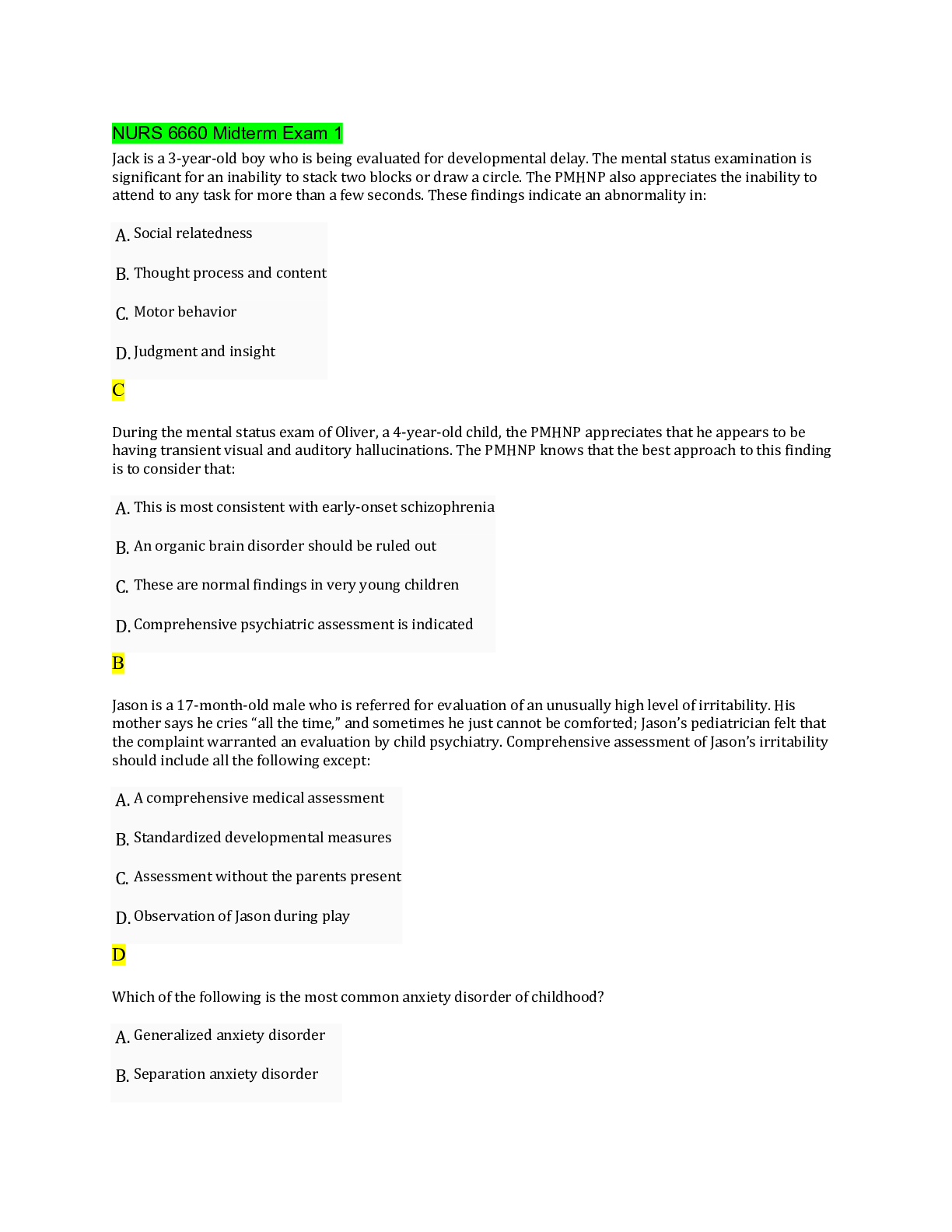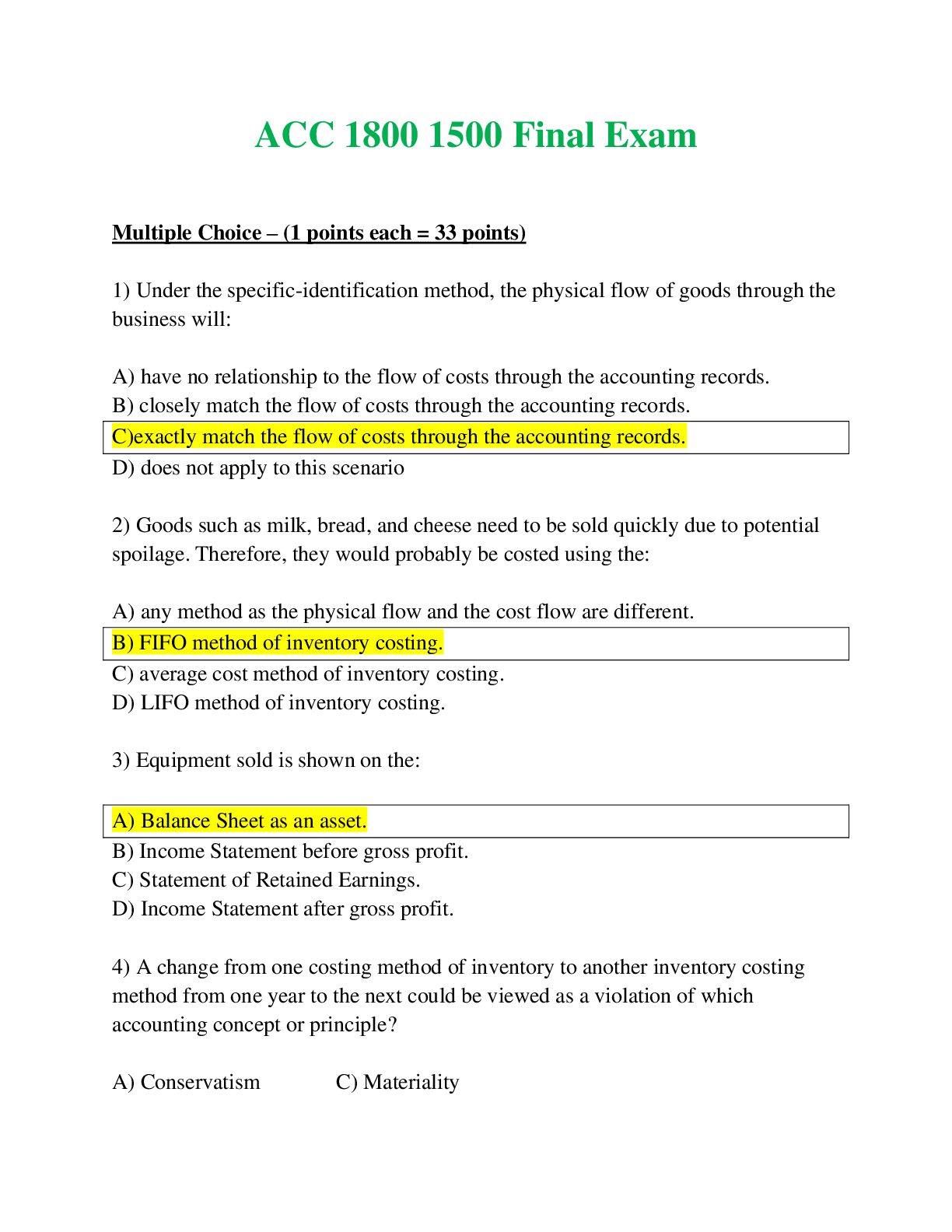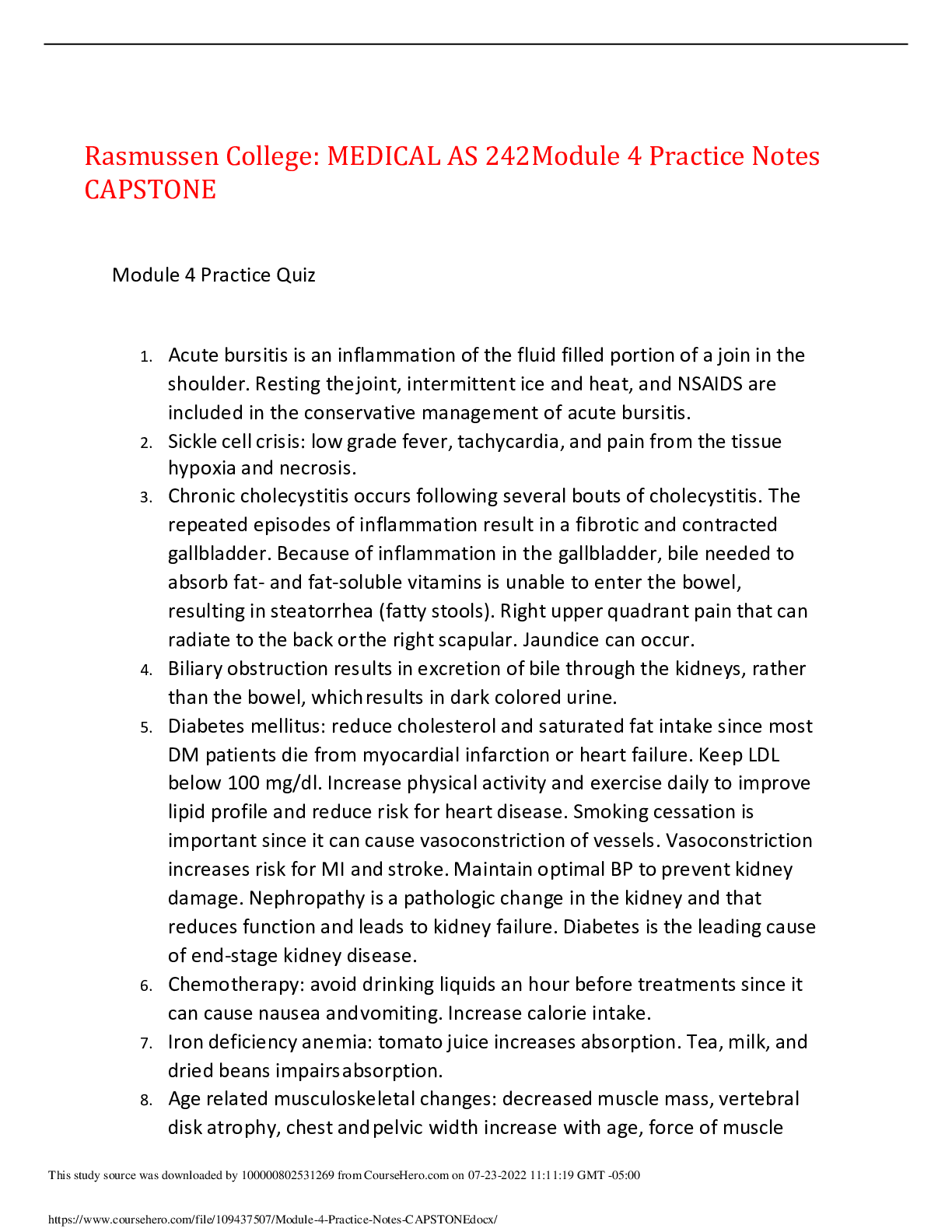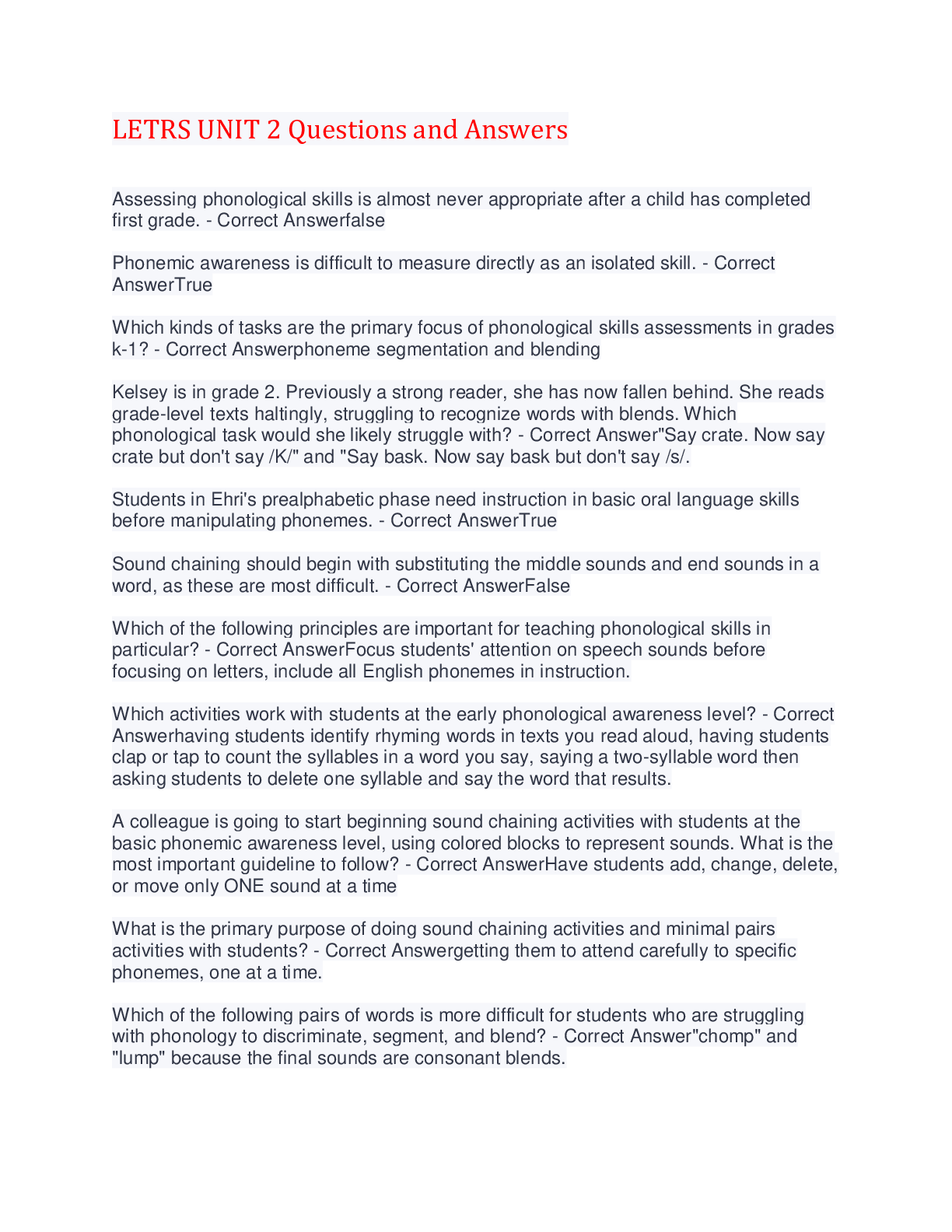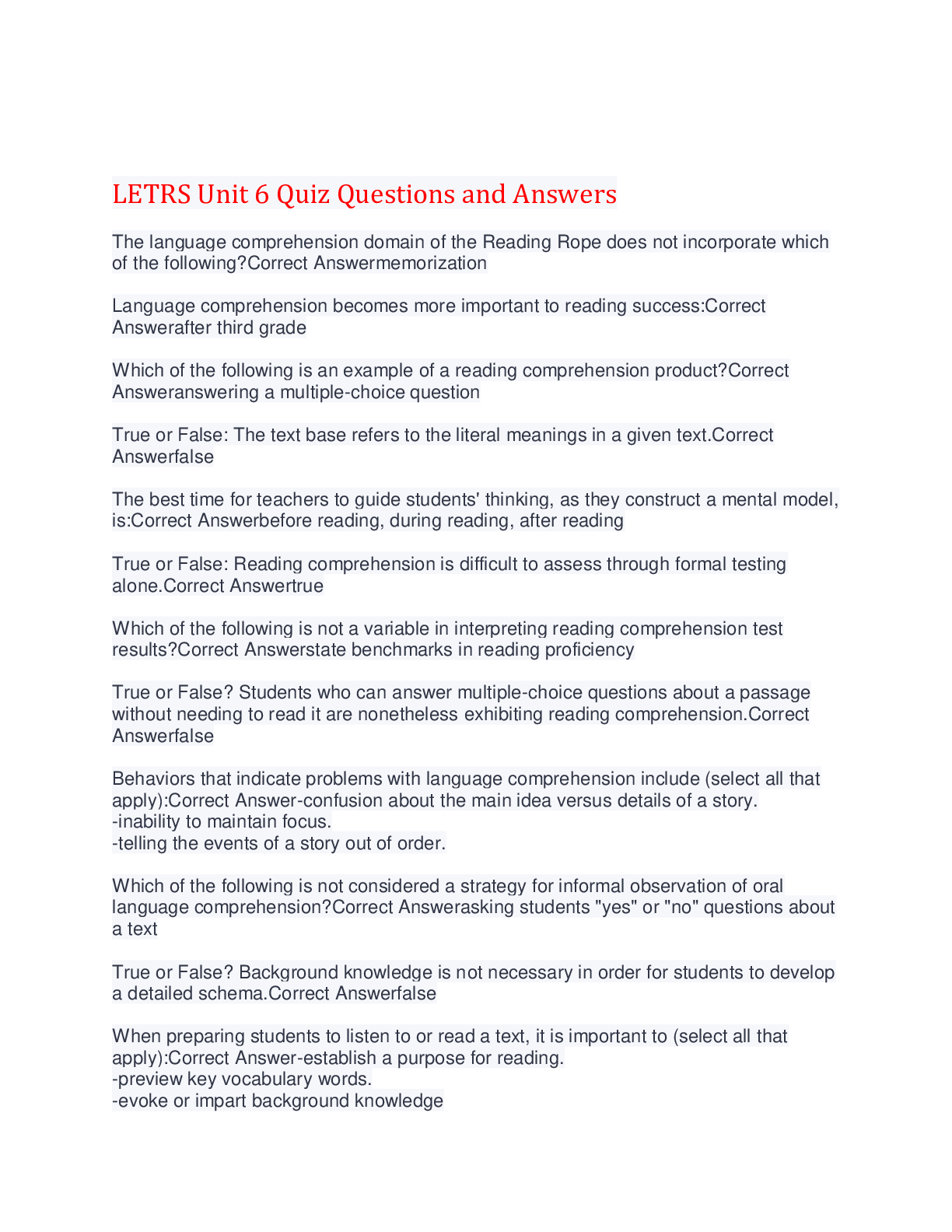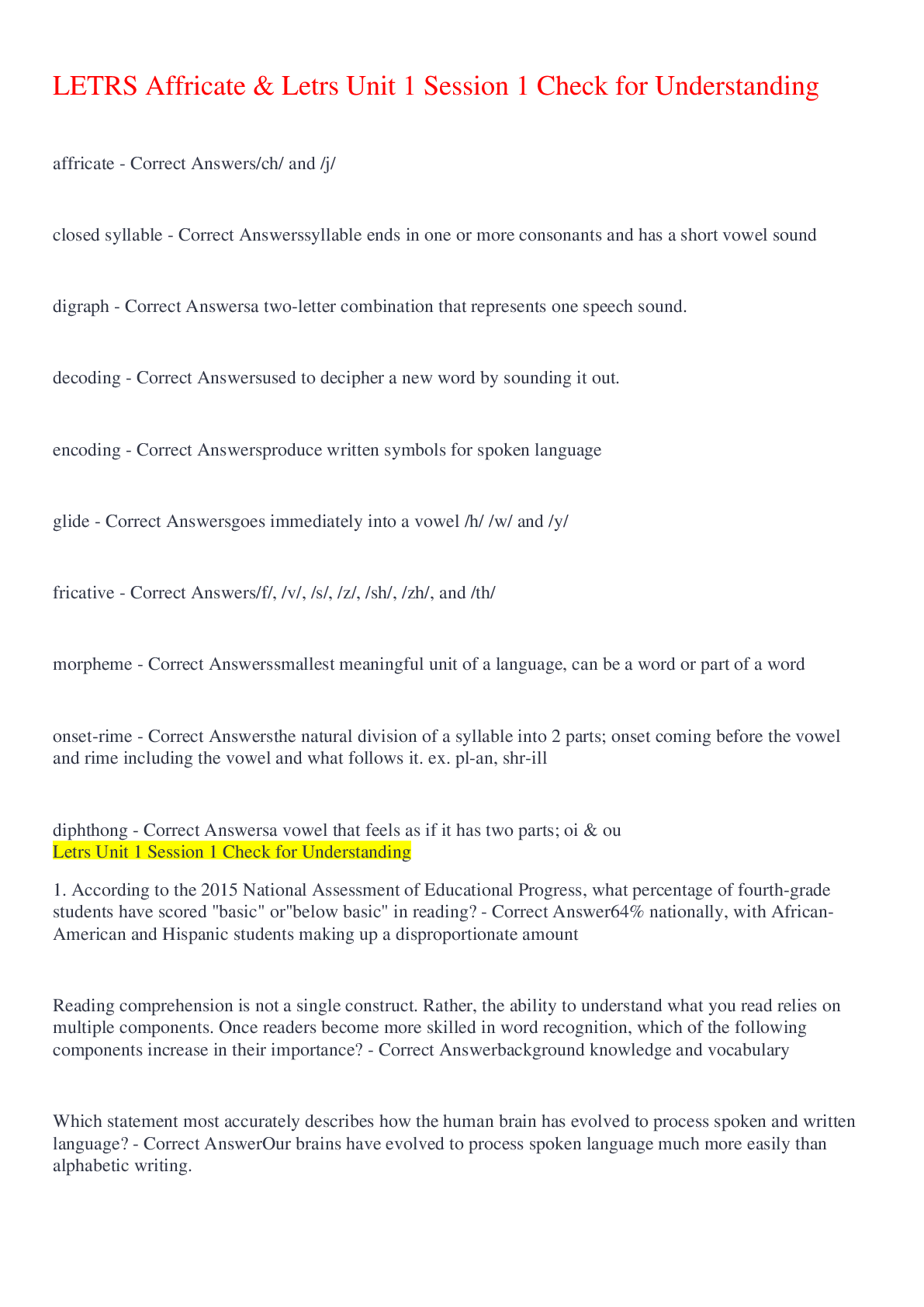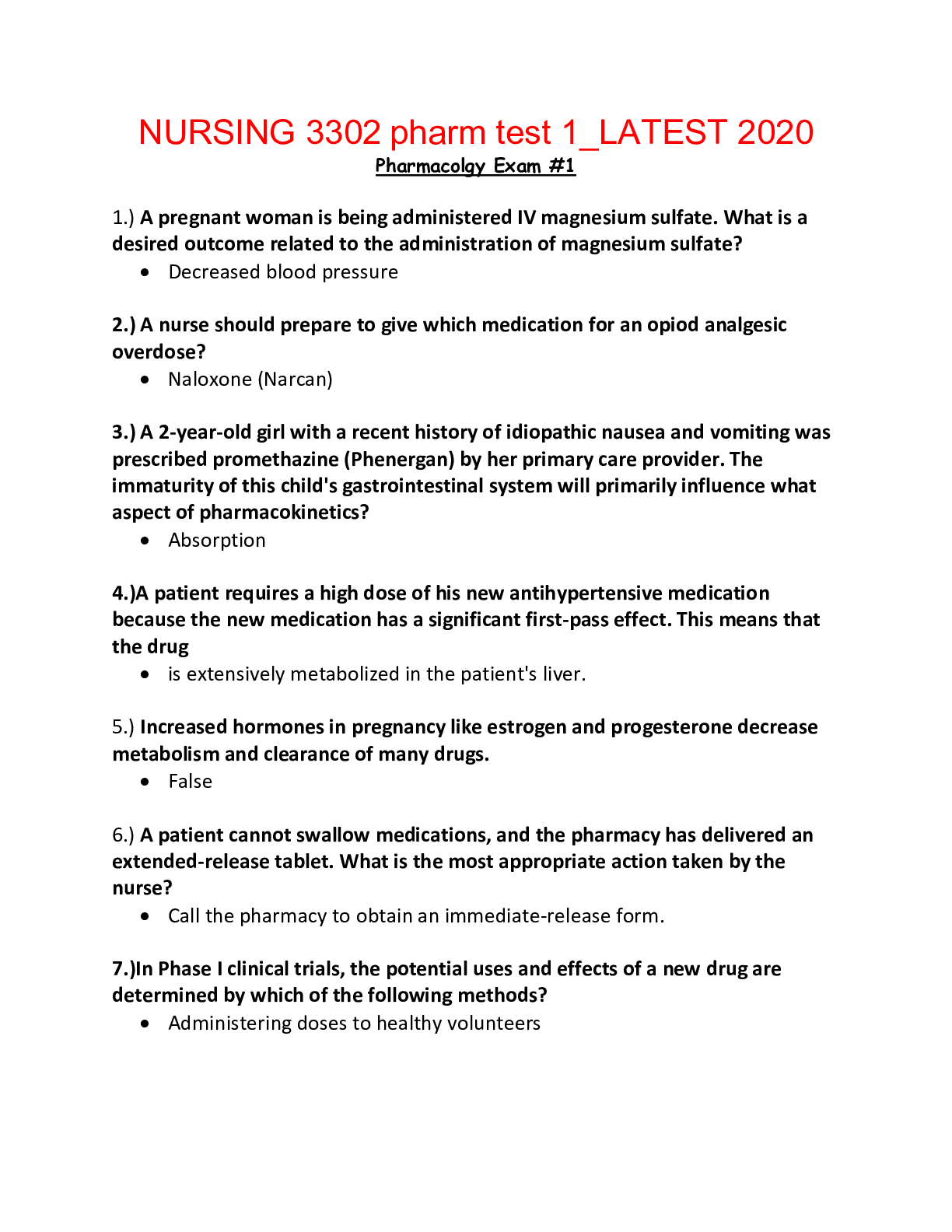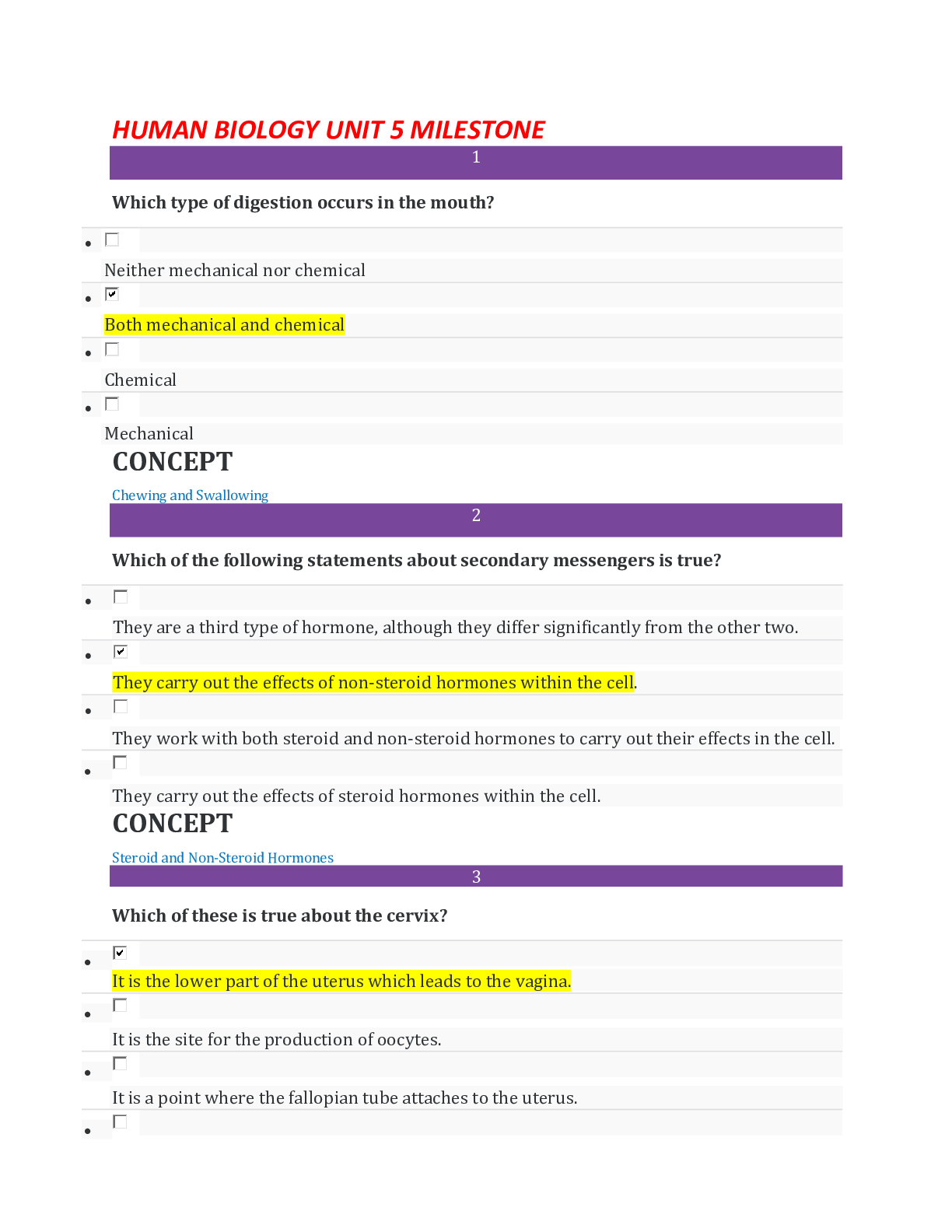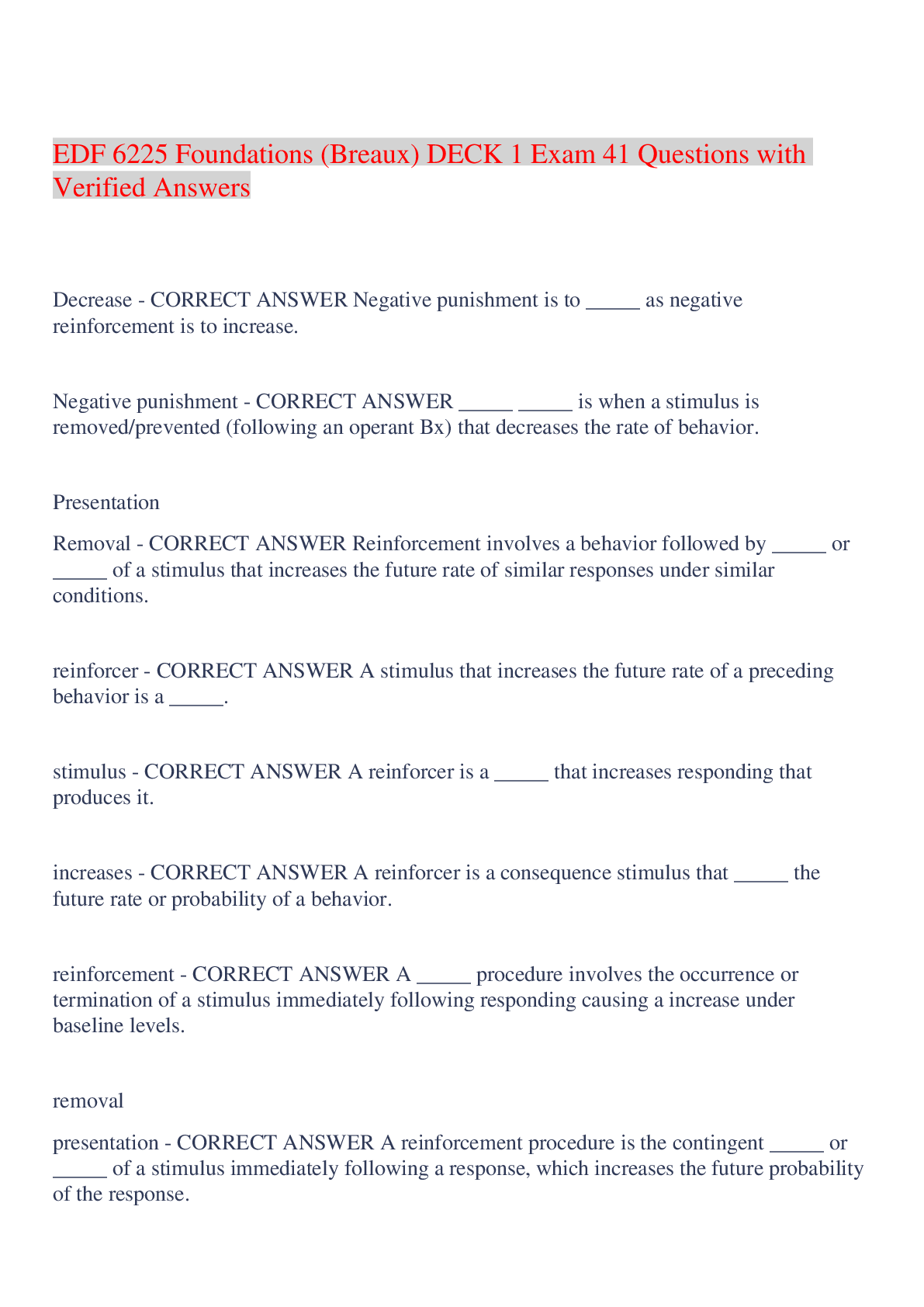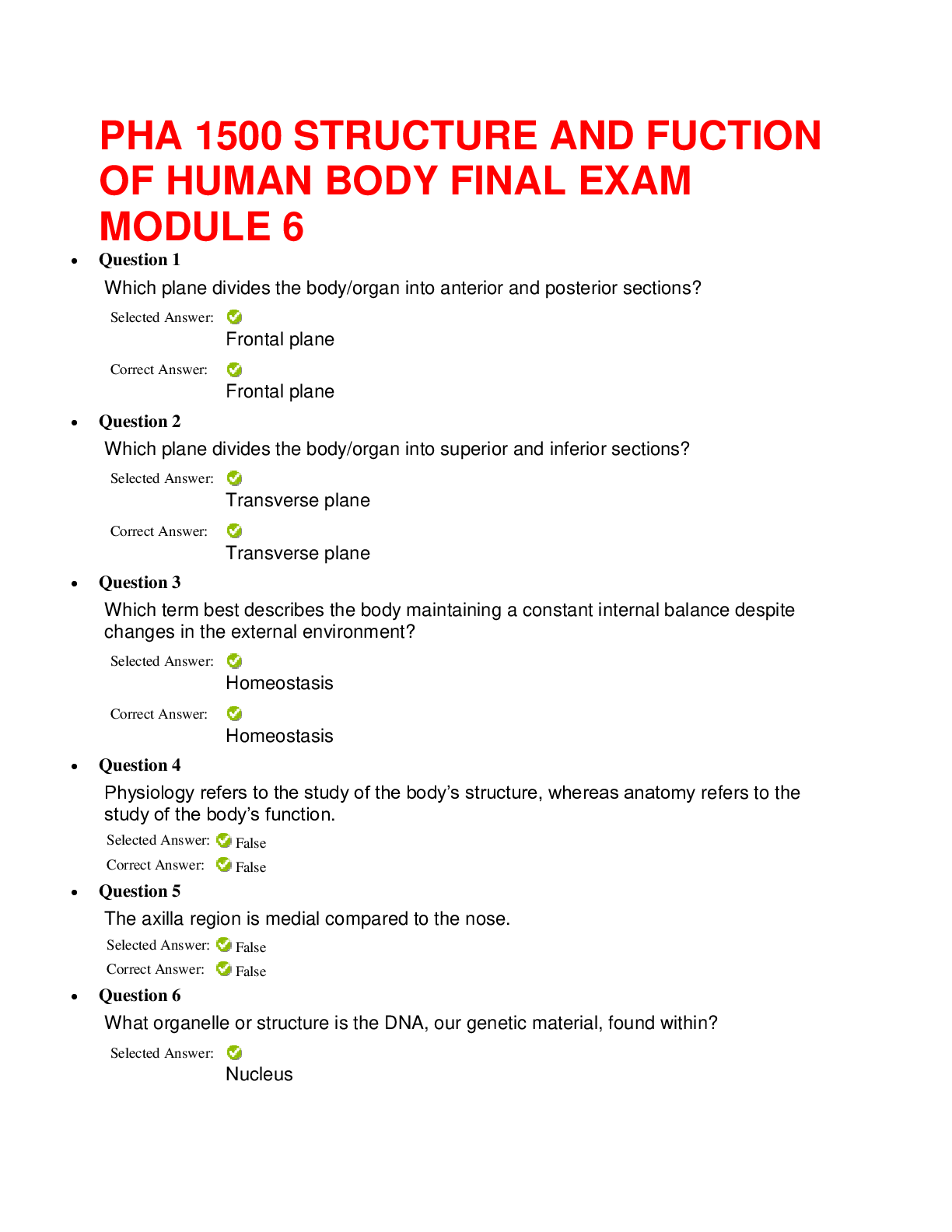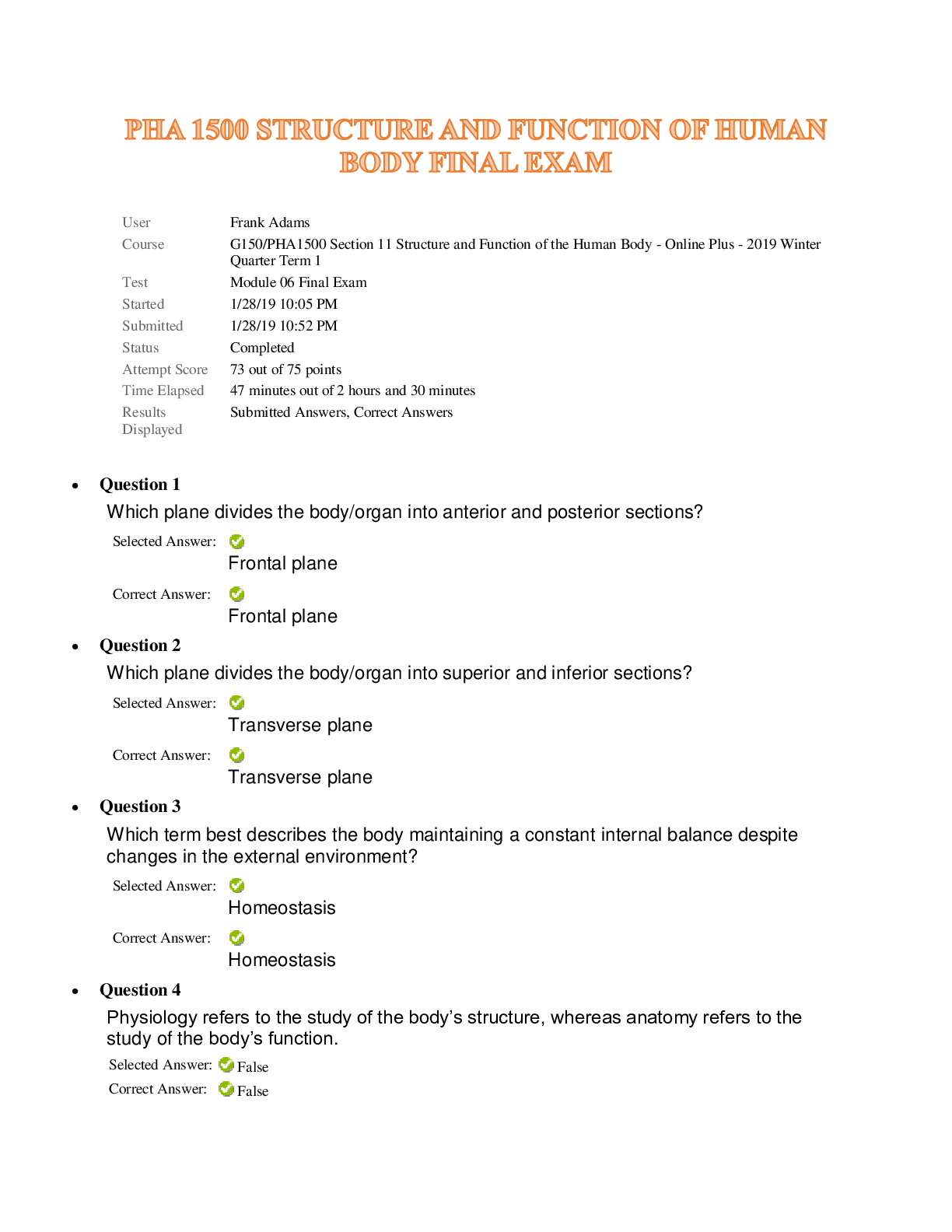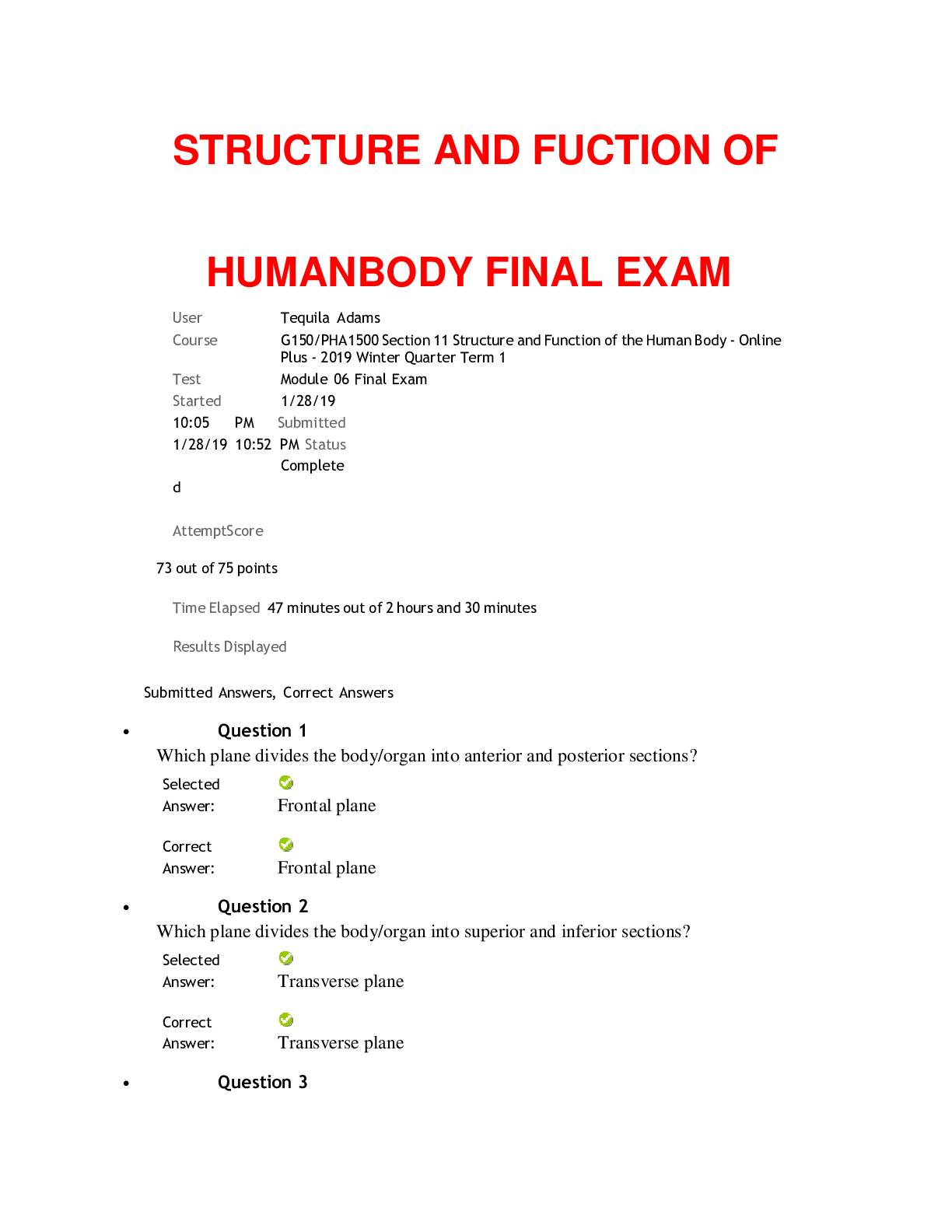STRUCTURE AND FUCTION OF HUMAN BODY FINAL EXAM MODULE 6,100% CORRECT
Document Content and Description Below
STRUCTURE AND FUCTION OF HUMAN BODY FINAL EXAM MODULE 6 Course G150/PHA1500 Section 11 Structure and Function of the Human Body - Online Plus - 2019 Winter Quarter Term 1 Test Module 06 Final Exam ... Started 1/28/19 10:05 PM Submitted 1/28/19 10:52 PM Status Completed Attempt Score 73 out of 75 points Time Elapsed 47 minutes out of 2 hours and 30 minutes Results Displayed Submitted Answers, Correct Answers • Question 1 Which plane divides the body/organ into anterior and posterior sections? Selected Answer: Frontal plane Correct Answer: Frontal plane • Question 2 Which plane divides the body/organ into superior and inferior sections? Selected Answer: Transverse plane Correct Answer: Transverse plane • Question 3 Which term best describes the body maintaining a constant internal balance despite changes in the external environment? Selected Answer: Homeostasis Correct Answer: Homeostasis • Question 4 Physiology refers to the study of the body’s structure, whereas anatomy refers to the study of the body’s function. Selected Answer: Correct Answer: Fals e Fals e • Question 5 The axilla region is medial compared to the nose. Selected Fals Correct Answer: Fals e • Question 6 What organelle or structure is the DNA, our genetic material, found within? Selected Answer: Nucleus Correct Answer: Nucleus • Question 7 Which phase of the cell cycle does the cell divide into two new cells? Selected Answer: Mitosis Correct Answer: Mitosis • Question 8 What is the state of balance in which the body’s internal environment (factors) remains within normal ranges? Selected Answer: Homeostasis Correct Answer: Homeostasis • Question 9 Which organelle is responsible for producing our body’s energy source, ATP? Selected Answer: Mitochondria Correct Answer: Mitochondria • Question 10 Where is our body’s DNA, genetic material, located? Selected Answer: Nucleus Correct Answer: Nucleus • Question 11 Which cellular structure is selectively permeable for specific items to freely pass through it? Answer: Plasma membrane Correct Answer: Plasma membrane • Question 12 The processes of diffusion and osmosis require energy, ATP, for it to occur. Selected Answer: Correct Answer: Fals e Fals e • Question 13 Cells have to replicate, or make a copy of, their DNA prior to going through mitosis and dividing into two new cells. Selected Answer: Correct Answer: Tru e Tru e • Question 14 Which type of tissue allows for the transmission of electrical impulses that provide communication signals with the body? Selected Answer: Nerve tissue Correct Answer: Nerve tissue • Question 15 Which type of tissue lines hollow organs, covers the outer surface of the skin and functions to provide protection or allow for absorption and secretion of substances? Selected Answer: Epithelial tissue Correct Answer: Epithelial tissue • Question 16 What statement is true of the skin? Selected Answer: The epidermis layer is continuously shedding old, dead skin cells and replacing them with new cells. Answer: The epidermis layer is continuously shedding old, dead skin cells and replacing them with new cells. • Question 17 A permanent tattoo will have ink in which layer or layers of the skin? Selected Answer: Dermis Correct Answer: Epidermis and dermis • Question 18 Which type of skin cell is involved in regulating our overall skin tone and color? Selected Answer: Melanocyte Correct Answer: Melanocyte • Question 19 Blood cell production is a function of the skeletal system. Selected Answer: Correct Answer: Tru e Tru e • Question 20 A sarcomere stores calcium within the muscle cell. Selected Answer: Correct Answer: Fals e Fals e • Question 21 What term is given to the end of long bones? Selected Answer: Epiphysis Correct Answer: Epiphysis • Question 22 Which section of the vertebral column contains seven vertebrae? Selected Answer: Cervical Answer: Cervical • Question 23 Calcium is a vital component for muscle contraction to occur. Selected Answer: Correct Answer: Tru e Tru e • Question 24 Osteoporosis is a bone disease that occurs when bone tissue loses enough mass to become extremely brittle. Selected Answer: Correct Answer: Tru e Tru e • Question 25 What best describes a muscle fascicle? Selected Answer: A bundle of muscle cells (fibers) Correct Answer: A bundle of muscle cells (fibers) • Question 26 ATP is needed in muscle contraction for what process? Selected Answer: For the release of the thick filament from the thin filament Correct Answer: For the release of the thick filament from the thin filament • Question 27 Muscle cells are filled with specialized proteins that allow for contraction to occur. Selected Answer: Correct Answer: Tru e Tru e • Question 28 Which neurons carry information from the central nervous system to the target gland, organ, or muscle? Selected Answer: Efferent neurons Correct Answer: Efferent neurons • Question 29 Which cerebral lobe of the brain is involved in our ability to see? Selected Answer: Occipital Correct Answer: Occipital • Question 30 Which region of the brain is involved in coordinated movement of large muscle groups, posture, and balance? Selected Answer: Cerebellum Correct Answer: Cerebellum • Question 31 The sympathetic nervous system will cause an increase to the heart rate and respiration rate. It will also cause the pupils to dilate. Selected Answer: Correct Answer: Tru e Tru e • Question 32 What lobe of the cerebrum controls our consciousness, intelligence and conscious movement of muscles? Selected Answer: Frontal lobe Correct Answer: Frontal lobe • Question 33 A neurotransmitter is a chemical released from the soma (cell body) of the neuron. Selected Answer: Correct Answer: Fals e Fals e • Question 34 The spinal cord transmits information from the body to the brain only. Selected Answer: Fals e Correct Fals Which region of the brain controls primitive functions of the body such as respiration rate, heart rate, sneezing, and coughing? Selected Answer: Brainstem Correct Answer: Brainstem • Question 36 Which hormone controls the body’s metabolism? Selected Answer: Thyroid hormone Correct Answer: Thyroid hormone • Question 37 Which endocrine gland secretes hormones that help the body adapt to stressful situations and release hormones that can reduce inflammation? Selected Answer: Adrenal gland Correct Answer: Adrenal gland • Question 38 The hormone insulin increases blood glucose (sugar) levels. Selected Answer: Correct Answer: Fals e Fals e • Question 39 Which receptors respond to factors such as pressure and stretch? Selected Answer: Mechanoreceptors Correct Answer: Mechanoreceptors • Question 40 Pain originating from the skin or joint that’s perceived as pain coming from an organ, such as the liver, is called referred pain. Selected Answer: Fals e Correct Fals The general senses are only found in localized areas of the body, such as the head, and includes pain, touch, and temperature sensation. Selected Answer: Correct Answer: Fals e Fals e • Question 42 What endocrine gland secretes a hormone that increases the blood calcium levels? Selected Answer: Parathyroid gland Correct Answer: Parathyroid gland • Question 43 What blood vessel carries blood away from the heart out to the body and typically carries oxygenated blood? Selected Answer: Artery Correct Answer: Artery • Question 44 What blood vessel carries blood back to the heart? Selected Answer: Vein Correct Answer: Vein • Question 45 Which type of blood vessel allows nutrient exchange between the blood vessel and body’s cells and tissues? Selected Answer: Capillary Correct Answer: Capillary • Question 46 Which heart chamber receives deoxygenated blood from the body? Selected Answer: Right atrium Answer: Right atrium • Question 47 Which heart chamber will pump oxygenated blood out to the body? Selected Answer: Left ventricle Correct Answer: Left ventricle • Question 48 The AV bundle, also called the pacemaker, assists in setting the heart rate of the heart? Selected Answer: Correct Answer: Fals e Fals e • Question 49 What type of blood cell assists in transporting oxygen throughout the body? Selected Answer: Erythrocytes Correct Answer: Erythrocytes • Question 50 What statement is true of type A+ blood type? Selected Answer: It will have type A antibodies in the plasma. Correct Answer: It will have type A antigen and the Rh antigen on the surface of its erythrocytes. • Question 51 Which disorder is characterized by an excessive white blood cell count? Selected Answer: Leukemia Correct Answer: Leukemia • Question 52 The myocardium of the heart contains the heart muscle that allows for muscle contraction. Selected Answer: Tru e • Question 53 Congestive heart failure occurs when a ventricle fails to effectively pump blood. Selected Answer: Correct Answer: Tru e Tru e • Question 54 When the immune system overreacts to a normal, non-harmful antigen as in the case of allergies, what type of immune disorder is this called? Selected Answer: Hypersensitivity Correct Answer: Hypersensitivity • Question 55 When the immune system is weak and cannot optimally perform its normal function, what type of immune disorder is this called? Selected Answer: Immunodeficie ncy Correct Answer: Immunodeficie ncy • Question 56 When a person contracts and gets a cold or infection, what type of immunity is this? Selected Answer: Natural active immunity Correct Answer: Natural active immunity • Question 57 Specific immunity is more effective when it has been previously been exposed to a specific bacteria or virus. Selected Answer: Correct Answer: Tru e Tru e • Question 58 The pancreas makes bile and stores it in the gallbladder, which assists in the digestion of lipids (fat). Correct Answer: Fals e • Question 59 The majority of nutrient absorption occurs in what digestive organ? Selected Answer: Small intestine Correct Answer: Small intestine • Question 60 Which nutrient is the primary source of energy (ATP) production for the body? Selected Answer: Carbohydrates Correct Answer: Carbohydrates • Question 61 The diaphragm and abdominal muscles are the main muscles that initiate the pulmonary respiration process to occur. Selected Answer: Correct Answer: Fals e Fals e • Question 62 Where does gas exchange occur within the respiratory system? Selected Answer: Alveoli Correct Answer: Alveoli • Question 63 What part of the nephron is involved in the glomerular filtration process of urine formation? Selected Answer: Renal corpuscle Correct Answer: Renal corpuscle • Question 64 The ureter transports urine from the bladder to the outside or external portion of the body. Selected Answer: Correct Answer: Fals e Fals e • Question 65 The stomach's main function is to mechanically digest food into a substance called chyme. Selected Answer: Correct Answer: Tru e Tru e • Question 66 It is the inner layer of the vagina that is sloughed off during the uterine (menstrual) cycle. Selected Answer: Correct Answer: Fals e Fals e • Question 67 What organ will produce estrogen and progesterone in the female reproductive system? Selected Answer: Ovary Correct Answer: Ovary • Question 68 Fertilization of an egg typically occurs here (first answer), while implantation of a fertilized egg occurs here (second answer)? Selected Answer: Fallopian tubes, uterus Correct Answer: Fallopian tubes, uterus • Question 69 What statement best describes the role of the epididymis? Selected Answer: Allows sperm to mature and is a storage location for sperm Correct Answer: Allows sperm to mature and is a storage location for sperm • Question 70 What is not an obstacle sperm face within the female reproductive system? Selected Answer: Cilia within the fallopian tubes Correct Answer: Cilia within the fallopian tubes • Question 71 Which organ of the female reproductive system produces the eggs and sex hormones estrogen and progesterone? Selected Answer: Ovary Correct Answer: Ovary • Question 72 The primary organ of the digestive system that produces digestive enzymes is the: Selected Answer: Pancre as Correct Answer: Pancre as • Question 73 What structure secretes progesterone during the last half of the ovarian cycle? Selected Answer: Corpus luteum Correct Answer: Corpus luteum • Question 74 Which type of nutrient is considered sugars and is the primary energy source for the body? Selected Answer: Carbohydrates Correct Answer: Carbohydrates • Question 75 Mechanical digestion is dependent upon digestive enzymes. Selected Answer: Fals e Correct Answer: Fals e [Show More]
Last updated: 2 years ago
Preview 1 out of 27 pages
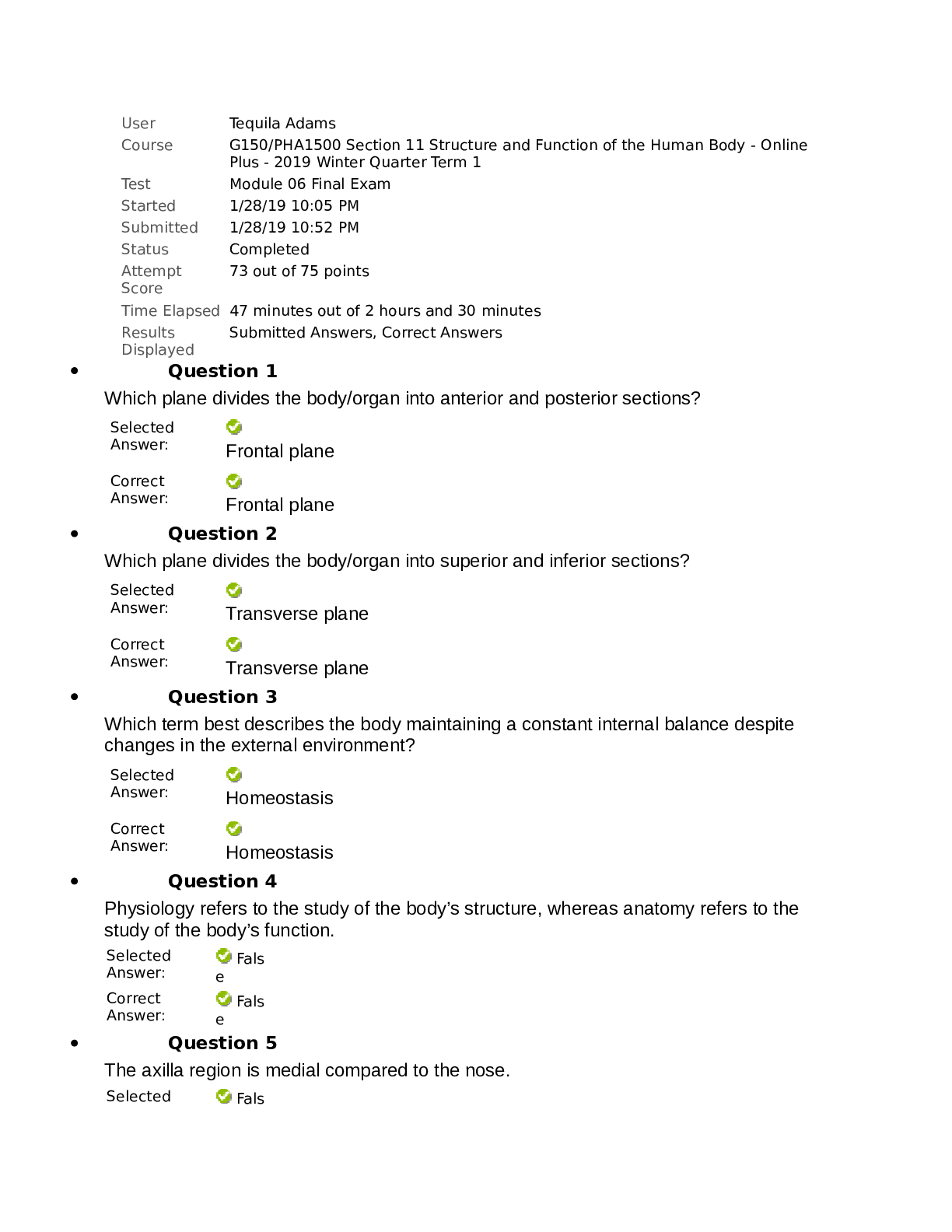
Buy this document to get the full access instantly
Instant Download Access after purchase
Buy NowInstant download
We Accept:

Reviews( 0 )
$16.00
Can't find what you want? Try our AI powered Search
Document information
Connected school, study & course
About the document
Uploaded On
Apr 17, 2021
Number of pages
27
Written in
Additional information
This document has been written for:
Uploaded
Apr 17, 2021
Downloads
0
Views
68


